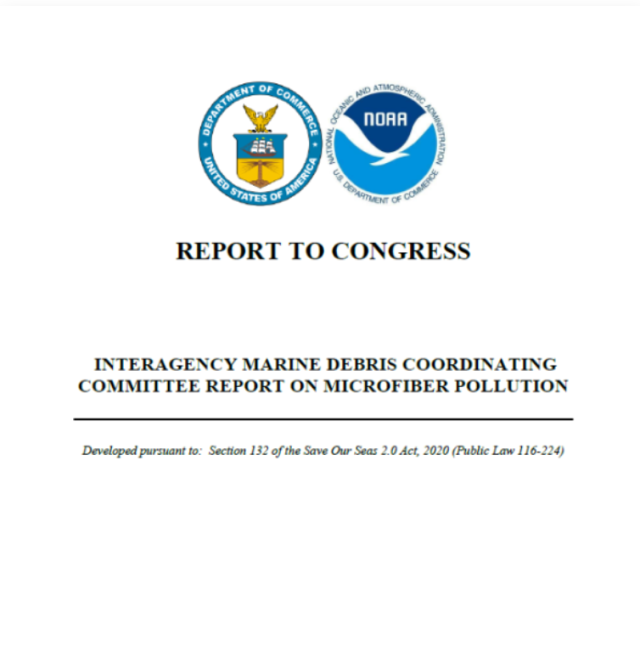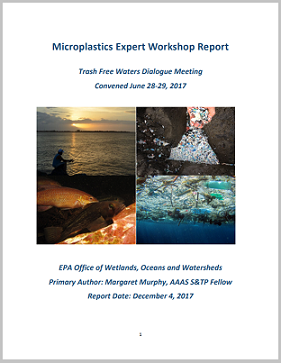Science & Case Studies
- Interagency Marine Debris Coordinating Committee Report on Microfiber Pollution
- Where the Rubber Meets the Road: Opportunities to Address Tire Wear Particles in Waterways (2023)
- Report on Priority Microplastics Research Needs: Update to the 2017 Microplastics Expert Workshop
- Microplastics Expert Workshop Report (2017)
- State of the Science White Paper: A Summary of the Effects of Plastics Pollution on Aquatic Life and Aquatic-Dependent Wildlife
- Summary of Expert Discussion Forum on Possible Human Health Risks from Microplastics in the Marine Environment
-
Tern Island Preliminary Assessment and Technical Support Document
EPA conducts analysis and research to address important issues related to the potential health, ecological, and socio-economic impacts of trash and debris in the aquatic environment.
Interagency Marine Debris Coordinating Committee Report on Microfiber Pollution

Pursuant to a requirement of the Save Our Seas 2.0 Act (P.L. 116-224), the Trash Free Waters Program and NOAA’s Marine Debris Program co-led the development of a Report to Congress, Interagency Marine Debris Coordinating Committee Report on Microfiber Pollution. This report was developed on behalf of the Interagency Marine Debris Coordinating Committee, with support from the consulting firm Materevolve and the National Marine Sanctuary Foundation. The content includes an overview of microfiber pollution, including a proposed definition of a microfiber, an assessment of the problem, and recommendations for measuring and reducing microfiber pollution. It also outlines a plan with five goals for Federal agencies to reduce microfiber pollution in coordination with stakeholders.
Where the Rubber Meets the Road: Opportunities to Address Tire Wear Particles in Waterways

EPA’s Trash Free Waters (TFW) program announces the publication of “Where the Rubber Meets the Road: Opportunities to Address Tire Wear Particles in Waterways.” Tire wear particles as a pollutant in waterways is a relatively new field of study without standardized terminology, assessment methodologies, or established solutions. The emergence of tire wear particles as a significant category of microplastics found in waterways prompted EPA to convene stakeholders in two roundtable discussions in Spring 2022 to facilitate shared learning about the challenges of addressing the problem of tire wear particle pollution. Stakeholders represented diverse perspectives on the nature of the problem and how to effectively address it. The roundtables provided a forum for discussion among participants without committing to a specific course of action. Participants discussed a set of questions aimed at understanding the barriers to and opportunities for managing tire wear particles in waterways. This brief report summarizes the roundtable discussions. In producing it, EPA seeks to share the challenges and potential solutions discussed during the roundtables, in order to inform the public and broaden the community engaged in addressing tire wear particle pollution.
- View the Report: Where the Rubber Meets the Road (pdf)
Report on Priority Microplastics Research Needs: Update to the 2017 Microplastics Expert Workshop

In June 2017, the U.S. Environmental Protection Agency (EPA) Trash Free Waters Program convened a workshop that brought together subject matter experts (SME) in the fields of environmental monitoring, waste management, toxicology, ecological assessments, and human health assessments to discuss and summarize the risks posed by microplastics to ecological and human health (See "Microplastics Expert Workshop Report" below). The resulting workshop report outlined priority scientific information needs within four broad categories of research: Field and analytical methods; sources, transport, and fate; ecological assessments; and human health assessments.
The EPA Trash Free Waters Program has updated the 2017 Microplastics Expert Workshop (MEW) report to assist the scientific research and funding communities in identifying information gaps and emerging areas of interest within microplastics research. This report includes a status update on the state of the science for each of the four categories listed above, informed by conversations with SMEs and a targeted review of the peer-reviewed literature.
- View the Report: A Trash Free Waters Report on Priority Microplastics Research Needs: Update to the 2017 Microplastics Expert Workshop (pdf)
Microplastics Expert Workshop Report

The EPA Trash Free Waters program convened a Microplastics Expert Workshop (MEW) on June 28-29, 2017 to identify and prioritize the scientific information needed to understand the risks posed by microplastics to human and ecological health. The workshop gave priority to gaining greater understanding of these risks, while recognizing that there are many research gaps needing to be addressed and scientific uncertainties existing around microplastics risk management. The workshop participants adopted a risk assessment-based approach and addressed four major topics: 1) microplastics methods, including deficits and needs; 2) microplastics sources, transport and fate; and 3) the ecological and 4) human health risks of microplastics exposure. Workshop participants recommended developed detailed conceptual models to illustrate the fate of microplastics from source to receptor and assess the ecological and human health risks of microplastics, the degree to which information is available for each, and the interconnections among these uncertainties. The expert panelists did not provide recommendations for specific regulatory or non-regulatory actions to be taken. This document presents a summary of the expert panel discussion.
State of the Science White Paper: A Summary of the Effects of Plastics Pollution on Aquatic Life and Aquatic-Dependent Wildlife

Plastics have become a pervasive problem in oceans, coasts, and inland watersheds. Recent estimates suggest that 4.8 to 12.7 million metric tons of plastic waste entered the global marine environment in 2010. Areas of accumulation of plastic debris include enclosed basins, ocean gyres, and bottom sediments. Plastics in the aquatic environment primarily originate from land-based sources such as littering and wind-blown debris, though plastic debris from fishing activities may be a key source in some areas. Plastic particles are generally the most abundant type of debris encountered in the marine environment, with estimates suggesting that 60% to 80% of marine debris is plastic, and more than 90% of all floating debris particles are plastic. This document is a state-of-the-science review – one that summarizes available scientific information on the effects of chemicals associated with plastic pollution and their potential impacts on aquatic life and aquatic-dependent wildlife.
Summary of Expert Discussion Forum on Possible Human Health Risks from Microplastics in the Marine Environment

The EPA Trash Free Waters program convened a panel of scientific experts on April 23, 2014. The purpose of the forum was to discuss available data and studies on the issue of possible human health risks from microplastics in the marine environment. The participating subject matter experts were asked to provide insights on the current scientific basis for determining human health risks, based on a review of scientific research done to date. The experts also were asked to identify data gaps and make suggestions for further study. The expert panelists did not provide recommendations for specific regulatory or non-regulatory actions to be taken. This document presents a summary of the expert panel discussion.
Tern Island Preliminary Assessment and Technical Support Document
In September 2014, EPA and the U.S. Fish and Wildlife Service released an initial assessment of contamination at Tern Island, a remote island in the chain of Northwestern Hawaiian Islands (NWHI). The results show that there have been releases of hazardous substances such as polychlorinated biphenyls (PCBs) and lead from military wastes buried on the island between World War II and 1979, and further action is warranted.
